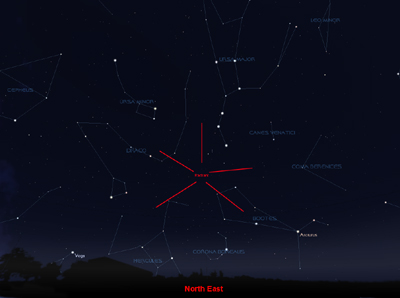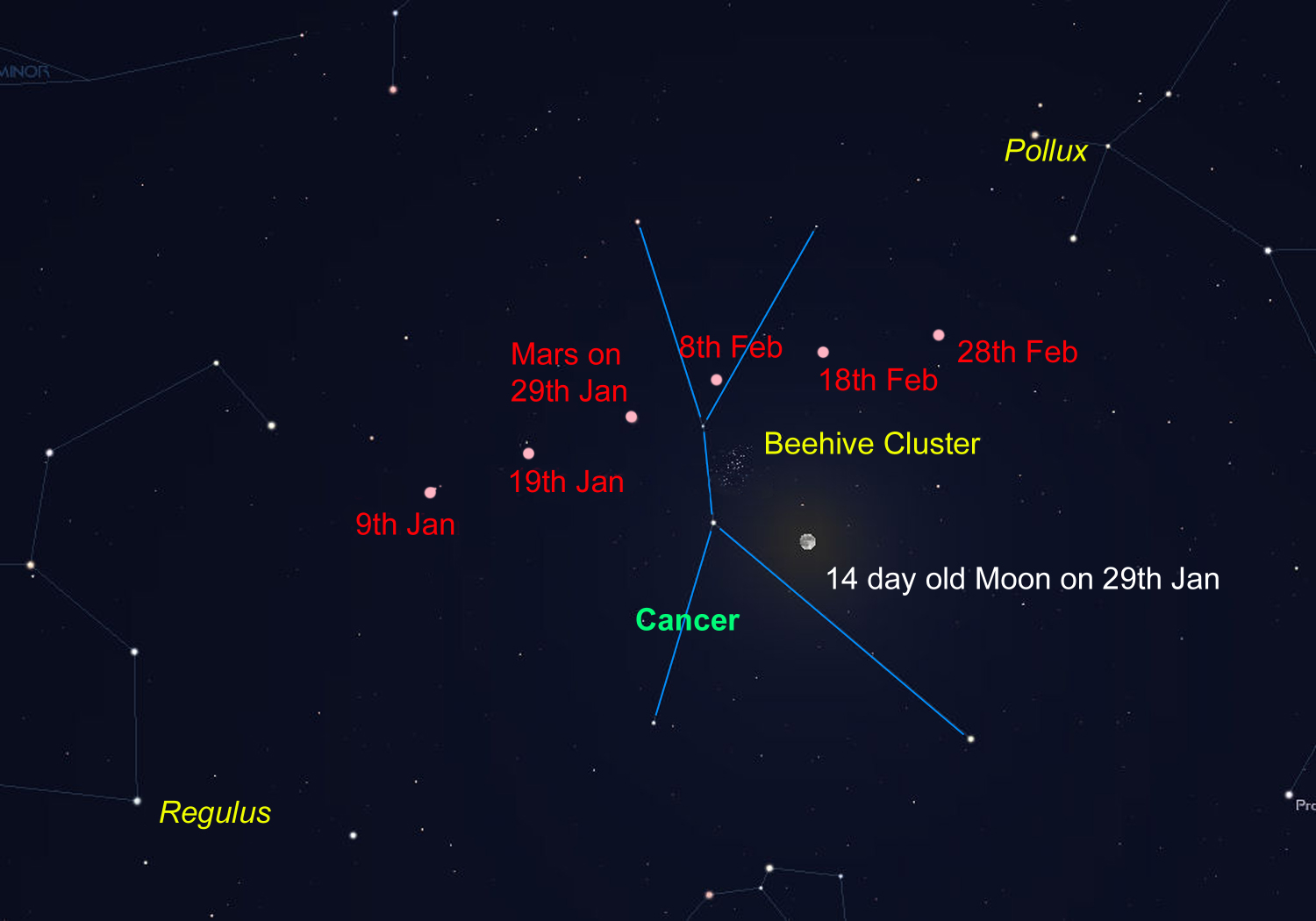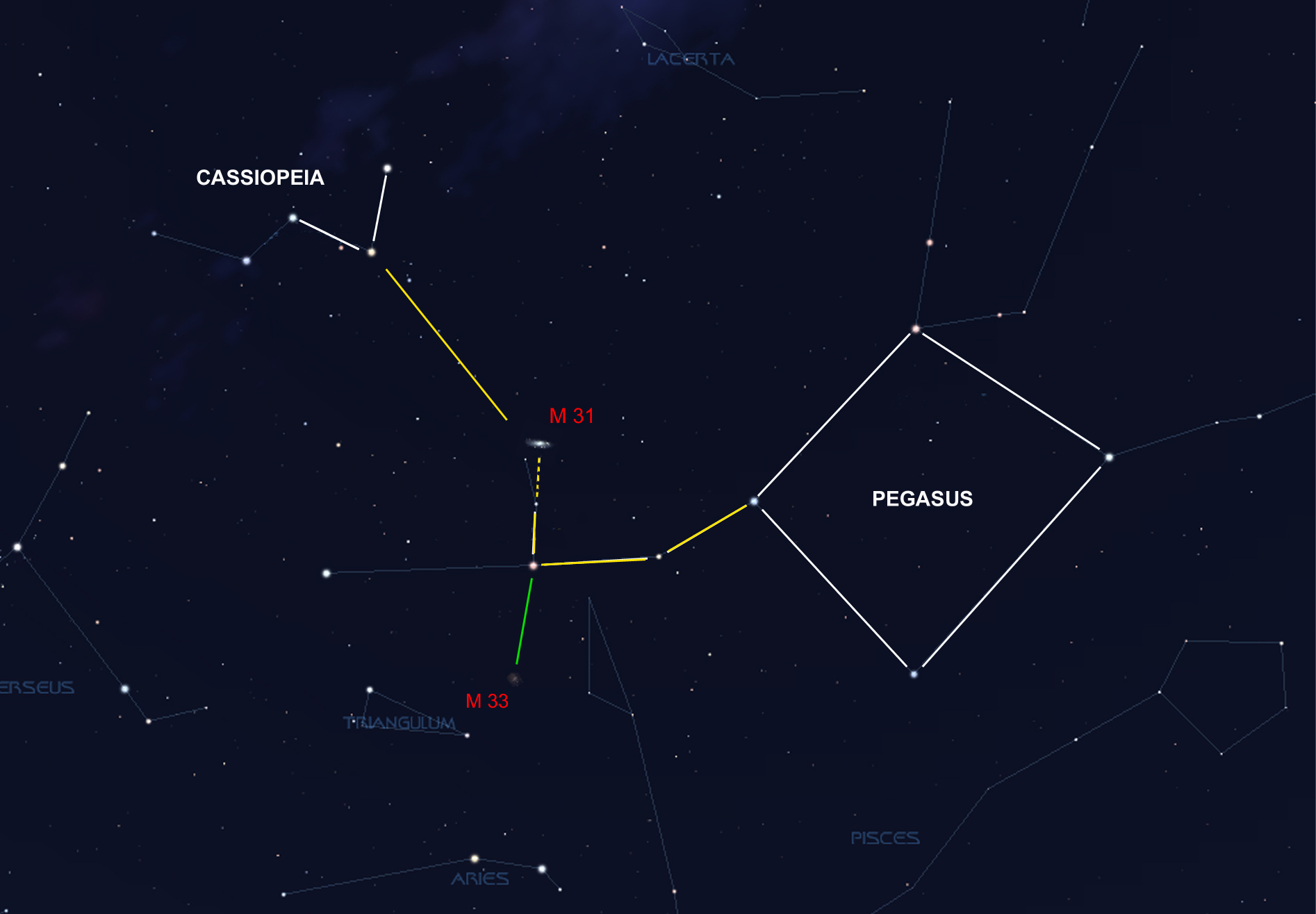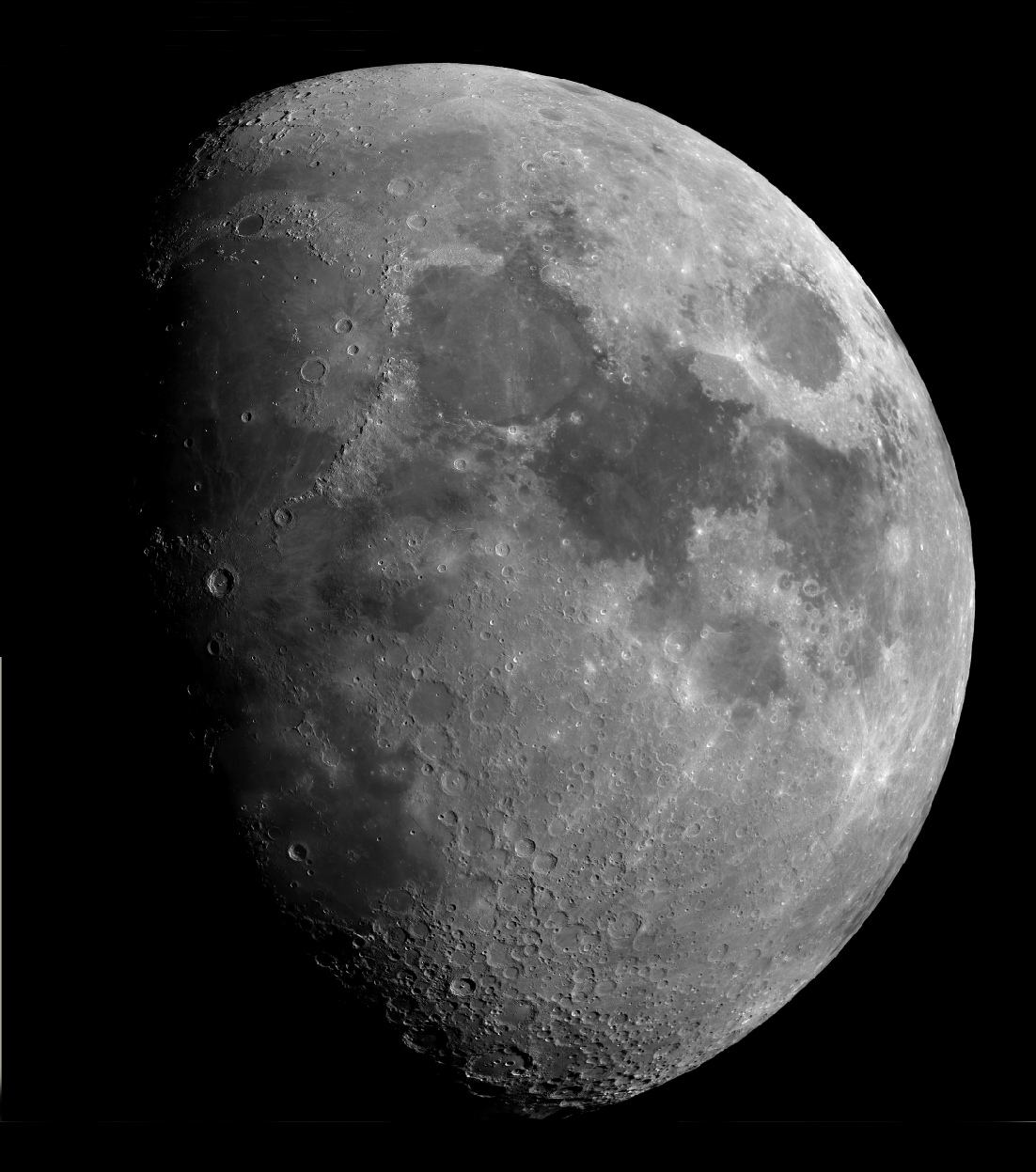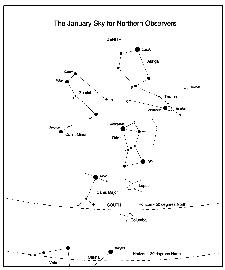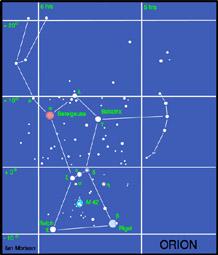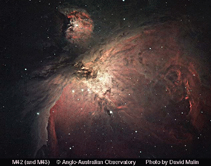The Night Sky January 2010
Compiled by Ian Morison
For December, click on link upper left.
This page, updated monthly, will let you know some of the things that you can look out for in the night sky. It lists the phases of the Moon, where you will see the naked-eye planets and describes some of the prominent constellations in the night sky during the month.
Image of the Month
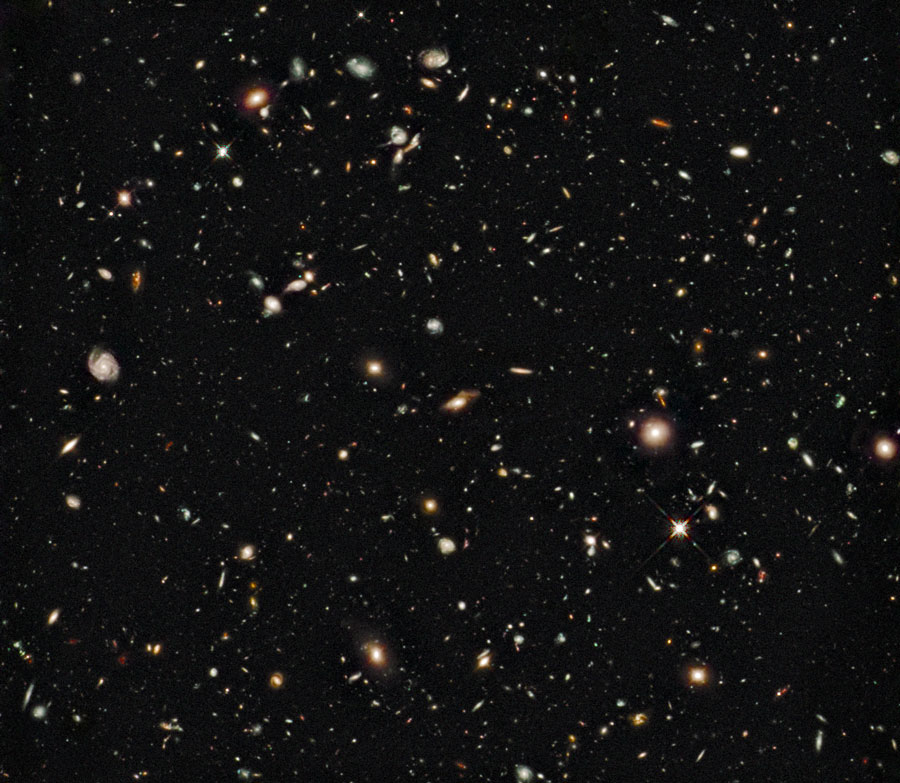
Hubble Ultra Deep Field in the near Infra-red
Image:NASA, ESA HUDF09 team
This image, taken by the Hubble Space Telescope, shows the Hubble Ultra Deep Field as imaged in 2004, but this time imaged in the near infre-red using the "Wide Field Camera 3" which was installed during the Hubble Telescope's recent servicing mission. It is the deepest near infra-red image ever taken, with some of the galaxies imaged being seen when the universe was only a few percent of its present age.
Highlights of the Month
Evening Jan 3rd: the Quadrantid Meteor Shower
The QuadrantidsThe early morning of Jan 4th will give us the chance, if clear, of observing the Quandrantid meteor shower. The shower is expected to peak on the morning of the 4th of January at about 5 am. Sadly this year, we are not best placed to observe them as the Moon is just 4 days after full and so brightening the sky. The rather narrow peak of activity is centered about 18:00 UT so early evening might well be best. The radiant - where the meteors appear to come from - is in the constellation Bootes not far below the tail of Ursa Major, the Great Bear. Here there was once a small constellation named after the "Quadrant" which was the device used by early astronomers - most notably Tycho - to measure the elevation of stars as they crossed the meridian (an arc running from horizon, due south, up to the pole star). Given the time at which this happens, it is possible to measure the star's celestial co-ordinates. The peak hourly rate can reach 200, but they are not particularly bright so a good dark observing site will help observe them. Whilst observing this part of the sky look at the central star of the tail of the Great Bear. Binoculars will easily show that there are two stars - Mizar,the brighter and Alcor, the Horse and Rider. You may even spot this with your unaided eye. A small telescope will show that Mizar is a nice double star! If it is clear it will be cold - so wrap up well, wear a woolly hat and have some hot drinks with you!
Mars at Closest Approach: see Mars at its best for a while.
Mars at closest approach.
January and Feburary are the best months to observe Mars for a couple of years as the Earth passes between Mars and the Sun on January 29th(called opposition. Mars will be due south around midnight so highest in the sky. Oppositions of Mars occur at intervals of approximatly 780 days but, because Mars has an eccentirc orbit (as has the Earth to a lesser extent) the distance of Mars at opposition varies widely. If Mars is at its closest point to the Sun (at perihelion) and the Earth at its most distant point from the Sun, the distance between the two will be at its smallest and so Mars will have its greatest angular size. This happened two apparitions ago when Mars was at its closest for ~ 60,000 years and had an angular size of 25 arc seconds. At the opposite extreme when Mars is at aphelion, the angular size only reaches ~14 arc seconds and, sadly, this is the case this year. Closest approach is on 27th Jan at a distance of nearly 100 million kilometres when its magnitude will be -1.3. Very nicely, it then lies in the constellation of Cancer just above the Beehive Cluster. The Moon, near full will be in attendance to as shown in the chart which shows its motion westwards across the sky over the next few weeks. The fact that its angular size is not as big as it can sometimes be is partly compensated for by the fact that it reaches an elevation of around 60 degrees, so the atmosphere will not impede our view as much as when it is lower in elevation.
To see significant detail on the surface requires a telescope of 4 inches or more. As the north pole is tilted towards us, we should be able to easily spot the, brilliant white, north polar cap. A slight pity for those with small telescopes is that the most prominent dark feature, Syrtis Major, passes behind the limb in the early evening, so will not be best seen. As Mars's day is similar in length to ours, we will see a similar face at a given time over quite a long period. The free Planetarium program "Stellarium" will show you what could be seen at any given time of the night during the apparition.Saturn begins to open its rings
11th January: Saturn and its satelltes before dawn.
Just to highlight the fact that Saturn is now rising in the late evening and so well seen in the pre-dawn sky. Find it down to the left of Leo between the star Regulus, in Leo, and Spica, in Virgo. On the 11th of January, Rhia, at magnitude +9.7 is close to Titan, at magnitude +8. Titan is easily seen in a small telescpe, but a 150mm telescope or more will be needed to see Rhia. Dione, close to the rings on the side of Titan, may also be spotted at magnitude 10.4, but close by Mimas, at magnitude 12.9 and, on the opposite side of Saturn, Enceladus at magnitude 11.7 will require an 8 to 10 inch scope.
Find M31 - The Andromeda Galaxy and, perhaps, M33 in Triangulum
In the evening, the galaxy M31 in Andromeda is visible reasonably high in the south-west. The chart provides two ways of finding it:
1) Find the square of Pegasus. Start at the top left star of the square - Alpha Andromedae - and move two stars to the left and up a bit. Then turn 90 degrees to the right, move up to one reasonably bright star and continue a similar distance in the same direction. You should easily spot M31 with binoculars and, if there is a dark sky, you can even see it with your unaided eye. The photons that are falling on your retina left Andromeda well over two million years ago!
2) As Pegasus sinks towards the horizon, you can also find M31 by following the "arrow" made by the three rightmost bright stars of Cassiopeia down to the lower right as shown on the chart.
M33: Having found M31, if you backtrack to the star where you turned sharp right and continue on for the same distance you may be able to spot the face on spiral galaxy, M33 in Triangulum if the skies are very dark and transparent. Binoculars will only show it as a faint smudge against the darker sky background. Sadly, quite a large telescope is required to see any detail. Good Hunting!
Observe the International Space Station

The International Space Station and Jules Verne passing behind the Lovell Telescope on April 1st 2008.
Image by Andrew Greenwood
Use the link below to find when the space station will be visible in the next few days. In general, the space station can be seen either in the hour or so before dawn or the hour or so after sunset - this is because it is dark and yet the Sun is not too far below the horizon so that it can light up the space station. As the orbit only just gets up the the latitude of the UK it will usually be seen to the south, and is only visible for a minute or so at each sighting. Note that as it is in low-earth orbit the sighting details vary quite considerably across the UK. The NASA website linked to below gives details for several cities in the UK. (Across the world too for foreign visitors to this web page.)
Note: I observed the ISS three times recently and was amazed as to how bright it has become.
Find details of sighting possibilities from your location from: Location Index
See where the space station is now: Current Position
The Moon

The Moon at 3rd Quarter. Image, by Ian Morison, taken with a 150mm Maksutov-Newtonian and Canon G7.
Just below the crator Plato seen near the top of the image is the mountain "Mons Piton". It casts a long shadow across the maria from which one can calculate its height - about 6800ft or 2250m.
| new moon | first quarter | full moon | last quarter |
|---|---|---|---|
| January 15th | January 23rd | January 30th | January 7th |
Some Lunar Images by Ian Morison, Jodrell Bank Observatory: Lunar Images
A World Record Lunar Image
To mark International Year of Astronomy, a team of british astronomers have made the largest lunar image in history and gained a place in the Guinness Book of Records! The whole image comprises 87.4 megapixels with a Moon diameter of 9550 pixels. This allows details as small as 1km across to be discerned! The superb quality of the image is shown by the detail below of Plato and the Alpine Valley. Craterlets are seen on the floor of Plato and the rille along the centre of the Alpine valley is clearly visible. The image quality is staggering! The team of Damian Peach, Pete lawrence, Dave Tyler, Bruce Kingsley, Nick Smith, Nick Howes, Trevor Little, David Mason, Mark and Lee Irvine with technical support from Ninian Boyle captured the video sequences from which 288 individual mozaic panes were produced. These were then stitched together to form the lunar image.
Please follow the link to go to the website and it would be really great if you could donate to Sir Patrick Moore's chosen charity to either download a full resolution image or purchase a print.
The Lunar World Record 2009: Lunar World Record
The Planets
Jupiter
Jupiter, now lying in Capricornus, can still be seen in the south-west after sunset but sets by 7:30pm in mid January. Its magnitude drops very slightly; from -2.1 to -2.0. It has an angular size of 34.7 arc seconds at the beginning of the month so a small telescope will show detail on the surface if seeing conditions are good, but its low elevation will not help!
Saturn
Saturn rises by 10:30 pm by the middle of the month and transits at 5 am at an elevation of ~39 degrees. The angular size of the disc stays around 18 arc seconds during the month. The ring system is still close to edge on (its tilt angle is 4.9 degrees at the beginning of the month) and so will still appear very thin - the reason why Saturn is not a bright as it is when the rings are more open. A small telescope will easily show its brightest satellite, Titan at magnitude 7.8, and one of 8 inches or more aperture several more. See highlight above.
Mercury
Mercury passes in front of the Sun - called inferior conjunction - on the 4th of January but reappears in the pre-dawn sky by the middle of the month. It is highest in the sky from the 17th to the 21st January, but will still be only 6 degrees above the horizon about one hour before sunrise so will be pretty hard to spot - not its best apparition!
Mars
Mars is now prominent in the evening sky, rising soon after sunset at the begining of the month. It will be well up in the south and thus highest in the sky around midnight. It crossed from the constellation Cancer into Leo on the first of December and continued to move eastwards into Leo until December 20th when it begins its retrograde path westwards and returns into Cancer on January 9th. This "retrograde motion" is because the Earth is overtaking Mars on the "inside track". Its magnitude increases from -0.9 to -1.2 during the month, whilst its angular size slowly increases from 13 to 14.1 arc seconds. See highlight above.
Venus
Venus. Venus is passing behind the Sun during January and is at Superior Conjunction (when it lies behind the Sun) on January 11th. We will have to wait until the middle of Febuary before we will have a reasonable chance of spotting it in the evening sky after sunset.
Find more planetary images and details about the Solar System: The Solar System
The Stars
The Mid to Late Evening January Sky
This map shows the constellations seen in the south around midnight. The brilliant constellation of Orion is seen in the south. Moving up and to the right - following the line of the three stars of Orion's belt - brings one to Taurus; the head of the bull being outlined by the V-shaped cluster called the Hyades with its eye delineated by the orange red star Aldebaran. Further up to the right lies the Pleaides Cluster. Towards the zenith from Taurus lies the constellation Auriga, whose brightest star Capella will be nearly overhead. To the upper left of Orion lie the heavenly twins, or Gemini , their heads indicated by the two bright stars Castor and Pollux. Down to the lower left of Orion lies the brightest star in the northern sky, Sirius, in the consteallation Canis Major. Finally, up and to the left of Sirius is Procyon in Canis Minor. There is also information about the constellation Ursa Major, seen in the north,in the constellation details below.
The constellation Taurus
Taurus is one of the most beautiful constellations and you can almost imagine the Bull charging down to the left towards Orion. His face is delineated by the "V" shaped cluster of stars called the Hyades, his eye is the red giant star Aldebaran and the tips of his horns are shown by the stars beta and zeta Tauri. Although alpha Tauri, Aldebaran, appears to lie amongst the stars of the Hyades cluster it is, in fact, less than half their distance lying 68 light years away from us. It is around 40 times the diameter of our Sun and 100 times as bright.

AAO Image of the Pleiades, M45, by David Malin
To the upper right of Taurus lies the open cluster, M45, the Pleiades. Often called the Seven Sisters, it is one of the brightest and closest open clusters. The Pleiades cluster lies at a distance of 400 light years and contains over 3000 stars. The cluster, which is about 13 light years across, is moving towards the star Betelgeuse in Orion. Surrounding the brightest stars are seen blue reflection nebulae caused by reflected light from many small carbon grains. These relfection nebulae look blue as the dust grains scatter blue light more efficiently than red. The grains form part of a molecular cloud through which the cluster is currently passing. (Or, to be more precise, did 400 years ago!)
Close to the tip of the left hand horn lies the Crab Nebula, also called M1 as it is the first entry of Charles Messier's catalogue of nebulous objects. Lying 6500 light years from the Sun, it is the remains of a giant star that was seen to explode as a supernova in the year 1056. It may just be glimpsed with binoculars on a very clear dark night and a telescope will show it as a misty blur of light.
Its name "The Crab Nebula" was given to it by the Third Earl of Rosse who observed it with the 72 inch reflector at Birr Castle in County Offaly in central Ireland. As shown in the drawing above, it appeared to him rather lile a spider crab. The 72 inch was the world's largest telelescope for many years. At the heart of the Crab Nebula is a neutron star, the result of the collapse of the original star's core. Although only around 20 km in diameter it weighs more than our Sun and is spinning 30 times a second. Its rotating magnetic field generate beams of light and radio waves which sweep across the sky. As a result, a radio telescope will pick up very regular pulses of radiation and the object is thus also known a Pulsar. Its pulses are monitored each day at Jodrell Bank with a 13m radio telescope.
The constellation Orion
Orion, perhaps the most beautiful of constellations, will be seen in the south at around 11 - 12 pm during January. Orion is the hunter holding up a club and shield against the charge of Taurus, the Bull up and to his right. Alpha Orionis, or Betelgeuse, is a read supergiant star varying in size between three and four hundred times that of our Sun. The result is that its brightness varies somewhat. Beta Orionis, or Rigel, is a blue supergiant which, at around 1000 light years distance is about twice as far away as Betelgeuse. It has a 7th magnitude companion. The three stars of Orion's belt lie at a distance of around 1500 light years. Just below the lower left hand star lies a strip of nebulosity against which can be seen a pillar of dust in the shape of the chess-board knight. It is thus called the Horsehead Nebula. It shows up very well photographically but is exceedingly difficult to see visually - even with relativly large telescope.
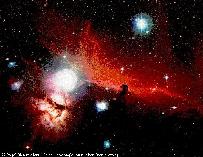
The Horsehead Nebula: Anglo Australian Observatory
Beneath the central star of the belt lies Orion's sword containing one of the most beautiful sights in the heavens - The Orion Nebula. It is a region of star formation and the reddish colour seen in photographs comes from Hydrogen excited by ultraviolet emitted from the very hot young stars that make up the Trapesium which is at its heart. The nebula, cradling the trapesium stars, is a beautiful sight in binoculars or, better still, a telescope. To the eye it appears greenish, not red, as the eye is much more sensitive to the green light emitted by ionized oxygen than the reddish glow from the hydrogen atoms.
The constellation Ursa Major
The stars of the Plough, shown linked by the thicker lines in the chart above, form one of the most recognised star patterns in the sky. Also called the Big Dipper, after the soup ladles used by farmer's wives in America to serve soup to the farm workers at lunchtime, it forms part of the Great Bear constellation - not quite so easy to make out! The stars Merak and Dubhe form the pointers which will lead you to the Pole Star, and hence find North. The stars Alcor and Mizar form a naked eye double which repays observation in a small telescope as Mizar is then shown to be an easily resolved double star. A fainter reddish star forms a triangle with Alcor and Mizar.
Ursa Major contains many interesting "deep sky" objects. The brightest, listed in Messier's Catalogue, are shown on the chart, but there are many fainter galaxies in the region too. In the upper right of the constellation are a pair of interacting galaxies M81 and M82 shown in the image below. M82 is undergoing a major burst of star formation and hence called a "starburst galaxy". They can be seen together using a low power eyepiece on a small telescope.
Another, and very beautiful, galaxy is M101 which looks rather like a pinwheel firework, hence its other name the Pinwheel Galaxy. It was discovered in1781 and was a late entry to Messier's calalogue of nebulous objects. It is a type Sc spiral galaxy seen face on which is at a distance of about 24 million light years. Type Sc galaxies have a relativly small nucleus and open spiral arms. With an overall diameter of 170,000 light it is one of the largest spirals known (the Milky Way has a diameter of ~ 130,000 light years).

M101 - The Ursa Major Pinwheel Galaxy
Though just outside the constellation boundary, M51 lies close to Alkaid, the leftmost star of the Plough. Also called the Whirlpool Galaxy it is being deformed by the passage of the smaller galaxy on the left. This is now gravitationally captured by M51 and the two will eventually merge. M51 lies at a distance of about 37 million light years and was the first galaxy in which spiral arms were seen. It was discovered by Charles Messier in 1773 and the spiral structure was observed by Lord Rosse in 1845 using the 72" reflector at Birr Castle in Ireland - for many years the largest telescope in the world.
Lying close to Merak is the planetary nebula M97 which is usually called the Owl Nebula due to its resemblance to an owl's face with two large eyes. It was first called this by Lord Rosse who drew it in 1848 - as shown in the image below right. Planetary nebulae ar the remnants of stars similar in size to our Sun. When all possible nuclear fusion processes are complete, the central core collpses down into a "white dwarf" star and the the outer parts of the star are blown off to form the surrounding nebula.


M97 - The Owl Planetary Nebula Lord Rosse's 1848 drawing of the Owl Nebula


